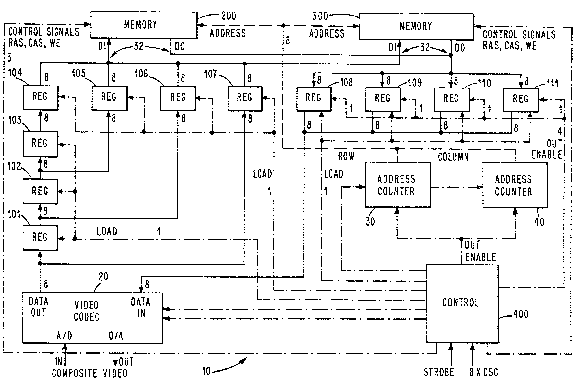Une partie des informations de ce site Web a été fournie par des sources externes. Le gouvernement du Canada n'assume aucune responsabilité concernant la précision, l'actualité ou la fiabilité des informations fournies par les sources externes. Les utilisateurs qui désirent employer cette information devraient consulter directement la source des informations. Le contenu fourni par les sources externes n'est pas assujetti aux exigences sur les langues officielles, la protection des renseignements personnels et l'accessibilité.
L'apparition de différences dans le texte et l'image des Revendications et de l'Abrégé dépend du moment auquel le document est publié. Les textes des Revendications et de l'Abrégé sont affichés :
| (12) Demande de brevet: | (11) CA 2006126 |
|---|---|
| (54) Titre français: | MEMOIRE A IMAGES VIDEO COMPOSITES |
| (54) Titre anglais: | COMPOSITE VIDEO FRAME STORE |
| Statut: | Réputée abandonnée et au-delà du délai pour le rétablissement - en attente de la réponse à l’avis de communication rejetée |
| (51) Classification internationale des brevets (CIB): |
|
|---|---|
| (72) Inventeurs : |
|
| (73) Titulaires : |
|
| (71) Demandeurs : |
|
| (74) Agent: | R. WILLIAM WRAY & ASSOCIATES |
| (74) Co-agent: | |
| (45) Délivré: | |
| (22) Date de dépôt: | 1989-12-20 |
| (41) Mise à la disponibilité du public: | 1990-07-03 |
| Licence disponible: | S.O. |
| Cédé au domaine public: | S.O. |
| (25) Langue des documents déposés: | Anglais |
| Traité de coopération en matière de brevets (PCT): | Non |
|---|
| (30) Données de priorité de la demande: | ||||||
|---|---|---|---|---|---|---|
|
87-3-218 CN -8-
COMPOSITE VIDEO FRAME STORE
ABSTRACT:
Apparatus stores a composite video frame including
synchronization signals, color burst signals, and analog
signals. The synchronization signals, color burst signals
and analog signals of a video frame are sampled and
digitized by circuitry: Two addressable memories are
provided. An input register coupled to first and second
memories buffers a plurality of digitized samples. An
output register coupled to said first and second memories
buffers the outputs of the memories. Address circuits
provide sequential addresses to the memories for each
cycle. During a write cycle, control means provide
control signals for enabling the input register to buffer
the samples and alternately write enabling the memories to
store said samples. During a read cycle, control signals
are provided for alternately read enabling the second
memories to output the samples and to enable the output
register to buffer the output. A circuit converts the
output into analog.
Note : Les revendications sont présentées dans la langue officielle dans laquelle elles ont été soumises.
Note : Les descriptions sont présentées dans la langue officielle dans laquelle elles ont été soumises.

2024-08-01 : Dans le cadre de la transition vers les Brevets de nouvelle génération (BNG), la base de données sur les brevets canadiens (BDBC) contient désormais un Historique d'événement plus détaillé, qui reproduit le Journal des événements de notre nouvelle solution interne.
Veuillez noter que les événements débutant par « Inactive : » se réfèrent à des événements qui ne sont plus utilisés dans notre nouvelle solution interne.
Pour une meilleure compréhension de l'état de la demande ou brevet qui figure sur cette page, la rubrique Mise en garde , et les descriptions de Brevet , Historique d'événement , Taxes périodiques et Historique des paiements devraient être consultées.
| Description | Date |
|---|---|
| Inactive : CIB de MCD | 2006-03-11 |
| Inactive : Abandon.-RE+surtaxe impayées-Corr envoyée | 1996-12-20 |
| Inactive : Demande ad hoc documentée | 1996-12-20 |
| Demande non rétablie avant l'échéance | 1995-06-20 |
| Le délai pour l'annulation est expiré | 1995-06-20 |
| Inactive : Demande ad hoc documentée | 1994-12-20 |
| Réputée abandonnée - omission de répondre à un avis sur les taxes pour le maintien en état | 1994-12-20 |
| Demande publiée (accessible au public) | 1990-07-03 |
| Date d'abandonnement | Raison | Date de rétablissement |
|---|---|---|
| 1994-12-20 |
Les titulaires actuels et antérieures au dossier sont affichés en ordre alphabétique.
| Titulaires actuels au dossier |
|---|
| GTE LABORATORIES INCORPORATED |
| Titulaires antérieures au dossier |
|---|
| JAMES C. STODDARD |